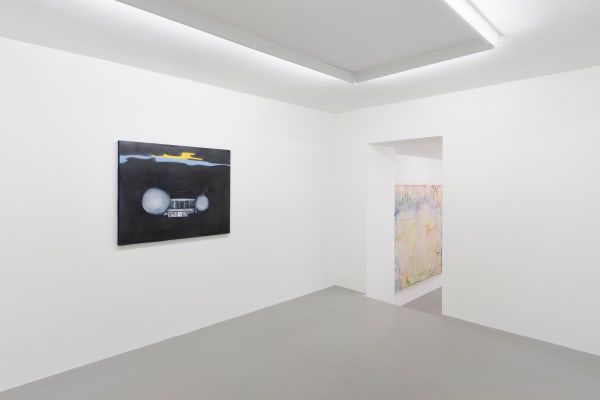Sophie Reinhold: Mercedes Benz
Past exhibition
Press Release
Groups of works might be made for exhibitions, but they must hold up on their own. That tension between the individual and the codependent can be lost over time or held tight at a painting's heart. These ten works were made for a specific place sometime a year ago. With a little bit of luck, the set is still intact. 9500 kilometers separates the two places, the one of conception and the second showing. How do we treat work that has already been shown before and recently? How do we accept the privilege of freeing work from its initial beginnings, as a whole? Humility and confidence help.
These works come from thinking about the place they were initially shown. What does that place mean to the artist? 30 years ago? Today? The exhibition becomes a Journey to the Center of the Earth. An idea ingrained early in the artist's mind as the West toppled all norms of the DDR with a colonial capitalism that went decades unquestioned. Maybe what was had before wasn’t worth trashing, maybe there’s a way to go back and forward at the same time. Vernes novel has been adapted across media and time endlessly. What’s an idea of a place at the center of the world? There’s an abstraction that happens when the center isn’t centered.
Picture yourself as a sundial clock, with forbidden functions depicted, you’re a medieval guy. Somebody calls you, you read it quite slowly, a guy with sundial thighs. After a pandemic, before the tightening of social norms by a church scared of losing its power, people depicted each other as we are and also as a grotesque imagined. A memento mori without a mission to gain. All bodily functions, all perversions. Each a reminder we could be even as they are. Just a couple of kids out there misbehavin’.
Some might see The Hunting of the Snark as an allegory. Lewis Carroll’s nonsense poem, about an endless search for happiness. Crossing the ocean with the Bellman’s map, an empty sheet of paper. In Reinhold’s work I see a negation of maps, a contradiction to Johns and the idea of an American painting. A profound chart of freedom.
Privatized propaganda interests Reinhold as much as the actual propaganda of her youth. She takes the 19th century cabbage head mascot, when advertising was a toddler and still very weird. Adorning him in an idea of California cool dress she throws him back at his own culture centuries later. Elsewhere an East German poster is rendered like a still from Mulholland Drive or Nocturnal Animals. The whole set of works, her practice, has a cinematic bend to it. Big paintings as backdrops. East German advertising was more about collectivity. America, and the West it inspires, markets to an individual. Socializing is only referenced in terms of the one. Another painting borrows its form from a poster explaining how not to die from electroshock. Marketing nothing but life. The form like Jesus on the cross, a moment of crucifixion, although can we really tell if the figure listened or is the lesson?
Two systems conflict. They’re being remixed. One to the West and one to the East. Freed from their original contexts and brought anew. The paintings and the ideas. Finding a common language to bridge that. Crossing borders, paint and the material of classical sculpture on the canvas together. Like a landscape filled with measurements, calculating the views real and rendered. As Galileo said, math is the language the universe was built with.
Twisting reality can be fun or dangerous or both. Fake news, flat earth, superhero movies and drugs. When you alter a face what does it show? What is normalcy in terms of physique? Blonde bombshells of perfection altered so that a mouth isn’t where a mouth should go. What’s the metaphor and what’s the stereotype?
Installation Views





















